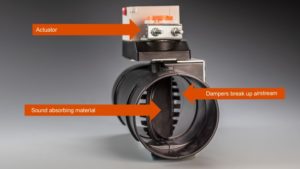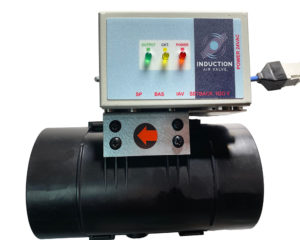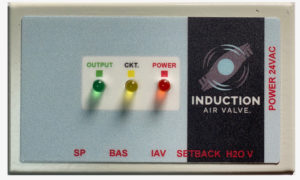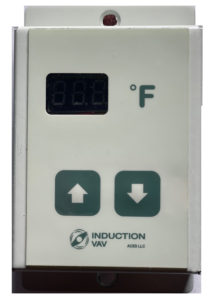 At the heart of the system is the IAV Valve and Actuator Unit. It is designed to work with any age existing induction units. We offer several proprietary and value-driven supporting products that ensure smooth and optimal performance, including the IAV Controller™, the IAV Thermostat™, and the IAV Diagnostic Tool™.
At the heart of the system is the IAV Valve and Actuator Unit. It is designed to work with any age existing induction units. We offer several proprietary and value-driven supporting products that ensure smooth and optimal performance, including the IAV Controller™, the IAV Thermostat™, and the IAV Diagnostic Tool™.

Our revolutionary Induction Air Valve (IAV) is the only air conversion valve that fits securely in existing perimeter induction unit inlets, where it converts constant air to energy-efficient variable air volume. Installation takes as little as 10 minutes per unit.
The valve is small with a 4” diameter that takes up only 4.5 inches of duct run when installed inside the existing unit inlet. The actuator receives and reacts to information from the thermostat and controller, opening or closing the airstream. A responsive damper inside the valve with multiple edge points breaks up the full airstream into mini airstreams, regulating airflow over the induction unit coil based on space requirements (VAV mode). Less air volume and a sound-absorbing core material substantially reduce noise from the induction unit.
 The IAV Controller is designed to work seamlessly with the IAV valve. The controller is a smart analog control device that uses the same electronics technology that put men in space and on the moon. It is field hardened, reliable and inexpensive.
The IAV Controller is designed to work seamlessly with the IAV valve. The controller is a smart analog control device that uses the same electronics technology that put men in space and on the moon. It is field hardened, reliable and inexpensive.
The IAV Controller is pre-mounted to the IAV valve, is quickly connected during installation, and is ready to go in as little as 10 minutes. It requires no programming, no expensive interfaces and is less than half the cost of direct digital controllers.
The controller has six plugs. The plugs attach the thermostat, power, valve motor, air solenoid valve, occupancy setpoint setback switch, and building automation system input /output (BAS I/O)
 The BAS I/O communicates a remote setpoint, winter/summer mode, occupied/unoccupied mode, and local remote setpoint mode. The controller sends to the BAS the actual room setpoint it is trying to maintain, the output of the controller and the room temperature.
The BAS I/O communicates a remote setpoint, winter/summer mode, occupied/unoccupied mode, and local remote setpoint mode. The controller sends to the BAS the actual room setpoint it is trying to maintain, the output of the controller and the room temperature.
| Costs | Central BAS Systems | Distributed Controls (Smart Thermostats / Controllers or Actuators | IAV Analog Computer Controllers |
|---|---|---|---|
| Original hardware | Requires less hardware, so less cost. | Requires one controller per zone, so initial hardware costs tend to be higher. | Low initial hardware costs compared to digital systems. |
| System installation and wiring | With fewer cabinets to install, installation costs are less. Wiring to inputs and outputs is more extensive and more costly. | Smart actuators come mounted to the valve and do not require wiring, making overall wiring costs less than central BAS. However, subnetwork installation and wiring are required. | Controller comes tested and factory mounted on the IAV valve. Wiring to inputs and outputs are local using network type plugs and cables except for power, which is plugged into a central power supply. Up to 8 controllers with a potential 56 I/O, including occupied/unoccupied, can be tied back to one power interface board. |
| System programming and commissioning | Less complicated subnetworks. Potential difficulty programming large processors. Trouble-shooting and commissioning programs are more extensive and more costly. | Commissioning is more expensive. Updating software can be expensive and time-consuming. | Contains dedicated logic requires no programming, no software or commissioning. |
| Hardware and software maintenance | Usually more points and high ongoing software licensing. | Usually more points and high ongoing software licensing. | All control logic is provided in the controller. Points are limited to keep software licensing costs negligible. |
| Unit costs | $2,500 - $3,500 per unit. A building with 1,000 controllers and 10 points per controller can add $10,000 per year to software licensing costs. | $1,800 - $3,000 per unit. | Typical costs are less than $700 per unit. |
 Like the IAV Controller, the IAV Thermostat is designed to work with the IAV System. It houses a very responsive Platinum RTD sensor. This sensor reacts much faster to changes in room temperature and is more precise than a pneumatic bulb thermostat. Temperature can be maintained to +/- one-tenth of a degree.
Like the IAV Controller, the IAV Thermostat is designed to work with the IAV System. It houses a very responsive Platinum RTD sensor. This sensor reacts much faster to changes in room temperature and is more precise than a pneumatic bulb thermostat. Temperature can be maintained to +/- one-tenth of a degree.
A Platinum RTD can be mounted in a thermostat box enclosure with a digital readout on the wall (shown) or on the induction unit itself with a digital display and membrane switches to change setpoint.
Replacing old constant air units with VAV units is another option for updating building heating and cooling. ACES has managed several replacement projects, including a recent partial replacement of 1,600 units at the Seagram Building, 375 Park Avenue. The modern units draw less outside air, improve air circulation and significantly cut energy usage, in this case saving $960,000 in energy costs in just the first year.